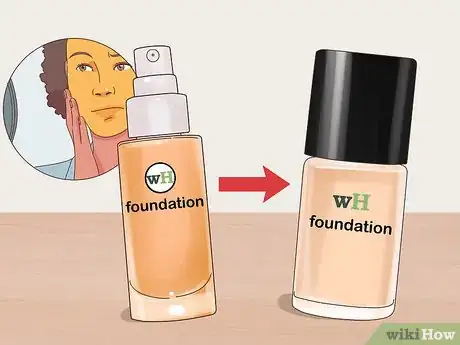This article was co-authored by Melissa Jannes. Melissa Jannes is a Licensed Esthetician and the owner of Maebee's Beauty Studio in Philadelphia, a single practitioner space providing quality services with individualized attention. Melissa is also a National Educator for Universal Companies. She received her esthetics degree at The Beauty School of Middletown in 2008 and is licensed in both New York and Pennsylvania. Melissa won the "Best of Beauty" award from Allure magazine in 2012 for the quality of her bikini waxing.
This article has been viewed 43,617 times.
You may struggle to keep your foundation looking effortless and natural throughout the day, especially when it has a tendency to turn a sudden shade of orange. Orange looking foundation is often caused by a reaction between your skin and the chemicals in the foundation. This can lead to oxidation, which can then create an orange looking hue on your skin. You can counteract orange looking foundation by adjusting your foundation shade and by applying your foundation properly. You can also make sure you maintain your foundation throughout the day so it looks fresh and natural.
Steps
Adjusting Your Foundation Shade and Type
-
1Try a lighter foundation shade. If you notice your foundation turns an unpleasant shade of orange whenever you use it, you may want to try going one to two shades lighter than your normal shade. Sometimes, using a lighter shade can make your foundation appear less dark and make any oxidation less noticeable on your skin. The lighter shade will help to counteract the appearance of an orange tinge on your skin, even if oxidation does occur.[1]
- You may try using a foundation that is one shade lighter than your normal shade in the same brand or switch to a brand that has a wider variety of shades. Make sure you test the foundation properly on your face to ensure the shade is not too light and will still blend well into your skin.
-
2Avoid foundations that contain SPF. Foundation with SPF is made of ingredients like zinc and titanium. These ingredients can then interact with the color products in the foundation, leading to a change in the shade color.
- You may opt for a foundation that does not contain SPF so you can avoid a reaction on your face that can lead to an orange tinge. Instead, you may invest in a setting powder that contains SPF so your skin is still protected from the sun but it is not at risk of turning orange.
Advertisement -
3Test the foundation before you use it. You should always test makeup on your skin before you commit to using it full time. You may try wearing a small patch of the foundation on the side of your face for a few hours to make sure it does not react with your skin and create an orange tinge. Or you may apply a full face of foundation and test it out at home for a few hours to ensure the shade does not change color.[2]
- You should test out all of your makeup products, from foundation to primer to eyeshadow, before you commit to using them on a day to day basis. This will ensure your skin does not have a negative reaction to any of the products.
Applying Your Foundation Properly
-
1Use a mattifying primer. If you have oily skin, you may be more susceptible to ending up with orange looking foundation. This is because the oils in your skin can interact with the foundation and change the shade. You can counteract excess oil on your skin by using a mattifying primer on your face before you apply foundation.
- Use a clean makeup brush to apply the mattifying primer on clean, exfoliated skin. This will ensure your foundation goes on smooth and is less likely to change shades.
-
2Make sure your face is dry before you apply foundation. It is also important that you let each product you use dry well on your face before layering or adding more product to it. Having excess moisture on your face can cause your skin to react with your foundation and lead to a change in the foundation shade.[3]
- Once you apply a makeup primer or a face moisturizer, let the product dry. Use your fingers to lightly touch your face to make sure the product has dried before you apply any foundation.
- You can also use blotting paper or a clean tissue to lightly dab away any excess moisture on your face, particularly on your T-zone area. This would be your forehead, your nose, and your chin.
-
3Dab on the foundation. Always apply your foundation properly and evenly so it appears fresh and clean on your face. Dabbing the foundation on with clean fingertips or using a clean makeup brush to stipple on the foundation will ensure it dries properly. It can also help to reduce the likelihood of the foundation appearing cakey, thick, or orange.[4]
- Try to apply one even layer of the foundation by dabbing or stippling it onto your skin. Blend the foundation in with clean fingers or a clean makeup sponge. Never sweep, rub, or smear on the foundation.
-
4Go for a setting powder that matches your foundation. You can try using a setting powder to help keep your foundation looking fresh and to avoid an orange tinge later on. Look for a setting powder that is the same brand as your foundation, as this will ensure the two products will react well with each other. Using a setting powder made by a different brand can lead to a negative reaction on your skin and oxidization, which can lead to an orange look.[5]
- Check that your foundation is dry before you apply setting powder. Use a clean makeup brush to apply the setting powder and make sure the setting powder sits on your skin in one, even layer.
Maintaining Your Foundation
-
1Use blotting papers on any oily areas. You can maintain your foundation throughout the day or night by keeping blotting papers with you. Check your foundation periodically and use the blotting papers to remove any oily areas on your skin. Removing excess oil can help to prevent oxidization and keep your foundation shade from changing color.[6]
- Always dab at any oily areas with the blotting papers or a clean tissue. Avoid rubbing or scrubbing any oily areas, as this will only ruin your foundation and can lead to breakouts or irritation on your skin.
-
2Moisturize your skin. You should make sure your skin is hydrated so it does not become dry or flaky. Use a water-based moisturizer to keep your skin hydrated, especially if you have oily skin. Try to get into the habit of applying moisturizer in the morning and at night so your skin stays hydrated.[7]
- Skin that is dehydrated can end up producing too much oil, leading to oily skin. Oily skin can then cause a reaction with foundation that can lead to a change in the shade.
-
3Switch foundations if it continues to turn orange. If you notice that your foundation continues to appear orange despite adjusting your foundation shade or type, you may need to switch to a different brand. Try several different brands to find the one that is right for you.
- Finding the right foundation for your skin can be tricky, so do not be afraid to ask a salesperson for help. You may also want to ask for samples of different foundations and test them all out to find the right brand and shade for your skin type.
Expert Q&A
Did you know you can get expert answers for this article?
Unlock expert answers by supporting wikiHow
-
QuestionWhy does my face look orange?
 Melissa JannesMelissa Jannes is a Licensed Esthetician and the owner of Maebee's Beauty Studio in Philadelphia, a single practitioner space providing quality services with individualized attention. Melissa is also a National Educator for Universal Companies. She received her esthetics degree at The Beauty School of Middletown in 2008 and is licensed in both New York and Pennsylvania. Melissa won the "Best of Beauty" award from Allure magazine in 2012 for the quality of her bikini waxing.
Melissa JannesMelissa Jannes is a Licensed Esthetician and the owner of Maebee's Beauty Studio in Philadelphia, a single practitioner space providing quality services with individualized attention. Melissa is also a National Educator for Universal Companies. She received her esthetics degree at The Beauty School of Middletown in 2008 and is licensed in both New York and Pennsylvania. Melissa won the "Best of Beauty" award from Allure magazine in 2012 for the quality of her bikini waxing.
Licensed Esthetician
-
QuestionHow do I keep my foundation from turning orange?
 Melissa JannesMelissa Jannes is a Licensed Esthetician and the owner of Maebee's Beauty Studio in Philadelphia, a single practitioner space providing quality services with individualized attention. Melissa is also a National Educator for Universal Companies. She received her esthetics degree at The Beauty School of Middletown in 2008 and is licensed in both New York and Pennsylvania. Melissa won the "Best of Beauty" award from Allure magazine in 2012 for the quality of her bikini waxing.
Melissa JannesMelissa Jannes is a Licensed Esthetician and the owner of Maebee's Beauty Studio in Philadelphia, a single practitioner space providing quality services with individualized attention. Melissa is also a National Educator for Universal Companies. She received her esthetics degree at The Beauty School of Middletown in 2008 and is licensed in both New York and Pennsylvania. Melissa won the "Best of Beauty" award from Allure magazine in 2012 for the quality of her bikini waxing.
Licensed Esthetician Match your foundation to both your skin tone and your undertone. If your foundation looks orange, it might be because you chose a warmer undertone but you have a more neutral or cool undertone. If you look at your wrist and your veins look more blue, you usually have a cooler undertone, but if they look deeper, like purple, your undertone is warmer.
Match your foundation to both your skin tone and your undertone. If your foundation looks orange, it might be because you chose a warmer undertone but you have a more neutral or cool undertone. If you look at your wrist and your veins look more blue, you usually have a cooler undertone, but if they look deeper, like purple, your undertone is warmer.
References
- ↑ https://www.youtube.com/watch?v=3FbVcrCz2bY
- ↑ https://www.youtube.com/watch?v=3FbVcrCz2bY
- ↑ https://bellatory.com/makeup/How-to-Keep-Your-Makeup-from-Turning-Orange
- ↑ https://bellatory.com/makeup/How-to-Keep-Your-Makeup-from-Turning-Orange
- ↑ https://www.youtube.com/watch?v=3FbVcrCz2bY
- ↑ https://bellatory.com/makeup/How-to-Keep-Your-Makeup-from-Turning-Orange
- ↑ https://bellatory.com/makeup/How-to-Keep-Your-Makeup-from-Turning-Orange
- Videos provided by Sam Ozkural



























































